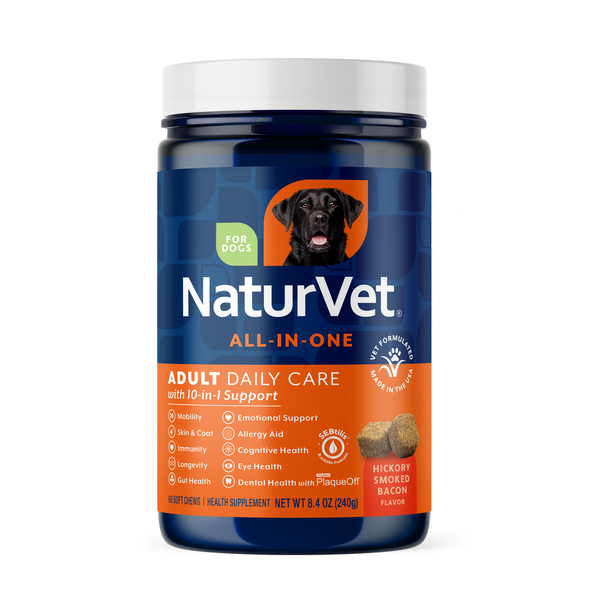How to Tell a Dog's Age: 5 Vet Tips
During the last couple of decades, interest in adopting pets from shelters and through rescue groups has increased dramatically, and for good reason.
As the human-animal bond continues to strengthen and pets become crucial members of the family, more folks want to identify with and meet the needs of a pup suffering from less fortunate circumstances.
But just about every rescue or adoption comes with a common challenge: how old is my new dog?
In this article, we’re going to discuss how you can narrow down your pooch’s approximate age using some tips vets use everyday. We’ll also discuss the favorite pastime of figuring out how old your dog is in human years.
How to Tell a Dog’s Age

Telling a dog’s age isn’t always an exact science, and ironically, your ability to age your dog accurately depends a lot on the true age of your pup.
Essentially, the younger a dog is, the easier it is to lock down his age, sometimes to a matter of weeks or months. But as he gets older, especially into adult and senior years, this gets much harder to determine.
Following are some of the best tips that vets use in practice to help pet parents get some idea of their new rescue or adoption’s age.
Detective Work: History
It may seem simple, but if you want to find out how old your new rescue or adoption is, start by finding out as much history about her as you can.
Sometimes, middle-aged or older pets will come with vet records or at least a history of how long they’ve been with a previous owner or foster. You often have to piece things together a bit, but sometimes you can at least get an approximate starting point.
Those Pearly Whites: Teeth
Aging a pup based on her teeth is by far the most accurate way to determine age. But the trick is, this method gets less accurate as time goes by.
All dogs start out by developing deciduous (baby) teeth that fall out after a few months as they are replaced by adult teeth. Age can be determined pretty accurately based on this process. According to a chart provided by the Humane Society of the US, this is the criteria I use for determining age based on tooth development and wear.
3-4 weeks
The baby canines are just starting to come in.
4-6 weeks
Deciduous (baby) incisors (little teeth in the front) and premolars start to come in.
8 weeks
By this time, all deciduous teeth should be present in most puppies. The only exception is that I find in very small breeds like chihuahuas or brachycephalic (the cute smushy-nosed) breeds like Pugs and Frenchies, that full eruption, or development, of baby teeth can be delayed by several weeks.
This is an important marker because if you’re fairly certain all of your puppy's baby teeth are in, this is around the best time for a first exam and vaccinations with your veterinarian.
4-5 months
Now we reach a bit of a gap. It can be hard to determine age accurately after all baby teeth are in, until the adult incisors start to develop. Around 4-5 months the first adult incisors will start to erupt, which may be seen first as the front two incisors suddenly being absent as they're being pushed out by the permanent teeth.
5-7 months
During this time, adult canines, premolars, and molars are coming in. In most dogs, all permanent teeth are in and at least almost fully erupted by 7 months.
1 Year
At 1 year, all teeth are fully erupted and nice and white and clean. Take note that there is a 5 month gap between 7 months and 1 year. At up to 2 years, teeth can still look pretty white and clean, so there can be some margin for error during this time.
2-3 Years
Dogs will start to develop some mild tartar on their teeth during this time. The earliest places will be near the gumline on the carnassial teeth (the very large upper 3-rooted premolars near the back) and the upper canines sometimes too.
3-5 Years
During this time frame, without dental care, we’ll see dental tartar continue to develop on all teeth, possibly with some early gingivitis.
5-10 Years
This time period has the greatest variability depending on the level of dental care a pet receives. Without brushing and periodic dental cleanings at the vet, we will see thick calculus build up on the teeth as well as some mild wear to some teeth, especially incisors, canines, and those large carnassial premolar teeth.
10+ years
If we continue to have a pet without significant dental care, we’ll continue to see further worsening disease of the teeth consisting of dental calculus build-up, gingivitis, root exposure, and sometimes loose or missing teeth.
Variability in Tooth Aging
As you might have guessed, while teeth are the most accurate way to determine age, there can be some variables in the reliability of using this method.
First, the smaller the dog, the faster they tend to build up tartar on their teeth. Miniature breeds, like chihuahuas, miniature poodles, and small terriers can develop significant tartar in just a couple of years. They have the same number of teeth as larger breed dogs, but less space for them to fit, allowing for more pockets and crevices for plaque to develop. This can give a false impression that miniature breeds are older than they really are.
Second, if your pup likes to chew on hard or abrasive objects, like bones and tennis balls, we can see the teeth either get fractured more often, or wear down far more quickly. It’s best to avoid these types of objects for general dental health throughout life, but they will definitely cause a premature age appearance.
Third, the type of food your pup eats can affect dental tartar build-up. Dogs eating harder foods, like kibble only, tend to develop less tartar over time. Dogs eating softer foods like canned food, fresh diets, or home-cooked diets, tend to have more build-up more quickly.
The fourth point is ironic. The better the dental care that’s provided for a pet, the harder it can be to use the teeth to tell an adult dog’s age based on progressive disease. Regular brushing and dental cleanings are good things, but if you happen to adopt a rescue pet that’s been through a few foster homes but has otherwise been well taken care of, it might be very hard to tell by the time they come into your home just how old she is.
The Graying Muzzle
As dogs age, it’s common to see some grey hairs develop, just like with people. The most common areas dogs go grey at first are the muzzle around the snout, and around the eyes. This can continue to extend along the top of the head. The time this can start is variable, but can begin in some dogs as early as 6 or 7 years. Most of the time though, if I see a dog with significant grey present, I suspect he’s at least around 10 years.
Cloudy Eyes
It’s a common question I get at senior pup appointments. Folks start to notice that their pooch’s eyes are looking “cloudy”.
Most often, this is a condition called lenticular sclerosis, also called nuclear sclerosis. As dogs age, the lenses in their eyes become harder and more condensed, making the eyes have a more opaque look from a distance.
While again, age of onset is variable, it’s generally accepted that about half of dogs have developed lenticular sclerosis by about 10 years of age.
Lenticular sclerosis is a normal aging process and not something that requires treatment, because fortunately, it rarely if ever affects vision. The tough part is that to the average pet parent's eye, it can be almost impossible to tell lenticular sclerosis from dreaded cataracts.
Cataracts are more concerning because they can actually block vision as they develop. They are caused when proteins that make up the structure of the lens start to clump together. The further underlying causes for them can include age, but also genetics, trauma, and systemic diseases like diabetes. Even young dogs can develop early onset cataracts, making cataracts a not so reliable source of a pup’s age.
If a new pup comes into your life and has some eye cloudiness, a visit to your vet can help. Using an ophthalmoscope, your vet can easily tell the difference between cataracts and lenticular sclerosis.
A Little Stiff in the Morning: Mobility
It might go without saying but in most cases, the younger the dog, the more active and mobile she is. As dogs age, it’s common for arthritis to develop in joints, especially the hips, back, elbows, shoulders, and knees.
The most telltale sign of arthritis show a dog that starts to get more stiff, especially when waking up from sleeping or resting. He’ll be a bit stiff as he stands and starts to move about, but usually, this stiffness wears off as he gets going.
In cases of early arthritis, dogs can still be pretty active, though it will take a toll over time if it goes unaddressed. Most of the time when seen, arthritis develops more significantly in dogs over 7 years. However, arthritis can develop in younger dogs that have a history of an orthopedic injury, like an ACL tear, or if they have a history of being overweight.
What’s My Dog’s Age in Human Years?
We all know that dogs live shorter lives than we do. The silver lining is that their shorter life-spans allow us to impact more pups in need of loving homes and we in turn have lives enriched by multiple canine companions.
As our pets age, many of us like to have an idea of how old our dogs are as compared to the lifespan of a human.
The old idea used to go that for every year a human ages, a dog ages seven.
But unfortunately, it’s not quite that simple. The comparison actually isn’t so linear. It follows more of an exponential curve, with a dog (at least on a chart) aging faster in his earlier years and then slowing down in his later years. Also consider that not all dogs age at the same rate. Small breed dogs typically live longer than giant breed dogs.
What you have is something much more complicated than a simple straight line comparing human years to dog years. But fortunately, there is a nice chart comparing these timelines that takes all of those factors into account, as first developed by Dr. Fred L. Metzger from UPenn’s veterinary school. While there are many charts out there, I find Dr. Metzger's to be the most accurate and easiest to understand.
As you can see in the chart, dogs are divided into different weight classes, and this makes a difference in terms of when a dog reaches different aging groups, especially the senior and geriatric stages of aging.
Age and Health
As the saying goes, age isn't a disease. But having at least a rough idea of how old your pooch is can be important for knowing what type of health needs to expect. You might not consider a joint health supplement if you think your dog is 5 years old when he’s actually 9 years old.
These tips can give you a good place to start. Sometimes, the DNA kits you can send out for can help provide an approximate age, but even they often need a reasonable starting point from you first. If you’re still not sure how old your dog is after using the criteria in this article, make sure to ask your vet the next time your pooch needs a check-up. It can still be a little bit of a guessing game, but we do it often enough that we can usually get pretty close.
And what happens if your pup is older than you thought? Your vet can help make health recommendations for you. But the good news is, your dog doesn’t have to know, and chances are, he wouldn’t care about a number anyway. He’ll still look to live every day to its fullest, to keep that strong bond with you.

























